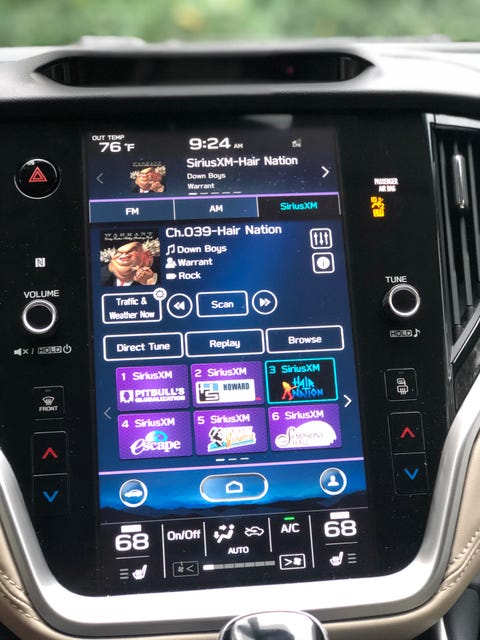I normally pay attention to ergonomics only when they’re unduly creative, which is to say infuriatingly useless. I have a theory that most innovation in basic automotive interfaces—stereo, shifter, turn signals—is aimed at impressing friends who borrow your car. “Oh, you want to take the Lexus? Well, it’s not the like cars you’re used to. So, let me show you how to work this holographic scroll wheel before you activate the Yodel drive. You just do different yodels for forward or reverse. It’s way easier than a shift lever once you nail the Hee-hoo! for park.”
But the 2020 Subaru Outback is notable for its radical normalcy. I actually noticed how well the interior controls conspired to prevent me from noticing anything. Let’s break it down.
The Shifter
It’s just a traditional mechanical lever poking out of the console. You pull it past one detent for reverse and all the way back for drive. Knock it to the side from there, and you can play with the pseudo gears programmed into the continuously variable transmission (CVT). It works all the time, day or night, without you looking at it or thinking about it. You don’t have to consult the owner’s manual to figure out how to use it. When it comes to something as fundamental as controlling the direction of the car—or making sure it’s stopped—this is what you want. And yeah, it probably takes up several extra square centimeters of center-console space compared to an electronic nub or a splay of buttons, but so what? Did you need something else crammed into the space for the shift lever? Get out of here. You’ve got enough cubbies.
The Cupholders
They’re ace. They’re fine. They’re big enough to hold the battered aluminum water bottle that you took backpacking across Panama during your gap year. Man, if that thing could talk—but you’re glad it can’t! Anyway, the cupholders include this weird little removable donut insert that can render one of them slightly shallower. The insert has a hole in the middle that seems custom-sized to trap your change. Yeah, I know it’s called a cupholder and not a change holder, but I’m just trying to be real with you about how this is going to play out.
The Screen
The loaded Outback Limited XT that I drove (which is priced at a reasonable $38,755) includes an 11.6-inch high-res touchscreen. That’s great for CarPlay or Android Auto, but the best part is that people who still listen to the radio get dedicated volume and tuner knobs flanking the screen. So you get your presets on the big screen, but you can still easily jump a few stations over with the tuner knob. This is the best way. Shout out to the Ram 1500. Shout out to the 2010 Lincoln MKT. The touchscreen-and-knobs crew rules.
The Seat Heaters
Oh no. No, no, no. Not this. The dreaded virtual seat-heater button. I know buttons cost more than software, and I’ve already praised Subaru’s restraint on its pricing, but physical hardware works so much better for this. Instead of just pressing a toggle or spinning a click wheel, you’ve got to stab a small square in the bottom quadrant of the screen. That cues the screen to go into climate-control mode, displaying your seat-heating options to the right. Then you jab away at that (three jabs, potentially, depending on how warm you want your seat to be), before it phantoms away. From the moment you press the seat-heater icon, you have about six seconds before the display banishes your seat-heating options. And yes, I timed it. Look, it’s not all Ferrari track days around here.
The Chargers
Like the Chargers of Los Angeles, the chargers of Outback initially look promising but end up delivering less than you’d hoped. By this, I mean that wireless charging pad under the USB ports is not actually a wireless charging pad. It’s just a rubber disappointment cubby. I guess you could get an aftermarket Qi charger and plug it into the 12-volt outlet in the center console, but I guess you could do a lot of things, like grow a beard entirely from your neck. Somewhere between terminals at the Atlanta airport, there’s a photo of a guy from the 1800s rocking that look, and it’s excellent, like a hair turtleneck. I’d show you a photo, but my phone was dead. Not blaming anybody.
Turn Signals
Few things make you look like a bigger dillwad than driving along with your turn signal on for miles and miles. Some turn-signal designs encourage that outcome, like electronic stalks that self center rather than staying in a set position. The Outback’s stalks stay where you put them, so you don’t end up forgetting them or bouncing the indicators from left to right in a futile attempt to cancel your signal. Everyone, listen: Do it this way. Except Ferrari. Ferrari can keep putting turn signals on the steering wheel so that it looks more button-y and Formula 1-y.
Cruise Control
It’s right there on the steering wheel, a speed toggle surrounded by four buttons. To the right are the buttons for on/off and lane keeping. (The latter function is awful squirmy. Don’t.) To the left, you have your distance control for the active cruise. One button to follow closer, another to back off. Simple! Grover from Sesame Street gets it. “Near! Faaaaar!” That’s it. No cycling through menus. Excellent execution.
Which, as it turns out, applies to most of the Outback’s interior interfaces. It’s not all perfect, but there’s nothing to make you rue the day you set foot in a Subaru dealer, either. That’s the way it should be: smart evolution, like the huge touchscreen, combined with familiar designs that just work. Speaking of which, the electronic parking brake is now in that category. And yes, the Outback has one. Get over it.





